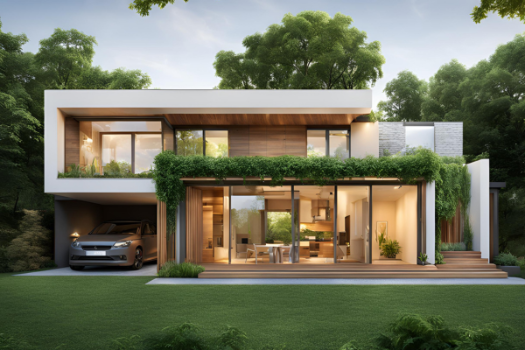.png)
How Generative Design with BIM Redefines Project Efficiency
Introduction
The construction industry is changing fast. Generative Design and Building Information Modeling (BIM) are at the center of this transformation. Together, they make projects more efficient by simplifying complex processes. Generative Design helps create multiple design options quickly, saving time and boosting creativity. BIM, on the other hand, ensures all the details of a project are organized and accessible to everyone involved.
This powerful combination allows professionals to explore better solutions, use resources wisely, and work together seamlessly. Teams can test designs, reduce waste, and meet project goals more easily than ever before. The results are more streamlined workflows and innovative ideas coming to life.
This article dives into how Generative Design and BIM are reshaping the construction process. From solving traditional challenges to offering smarter ways of working, this synergy is paving the way for a more efficient and sustainable future.
Understanding Generative Design and BIM
Generative Design is a process that uses advanced algorithms to create multiple design options. Designers set specific goals and constraints, and the system generates solutions that meet these criteria. This allows teams to explore a wide range of possibilities, making it easier to choose the best option. It speeds up decision-making while ensuring designs are efficient and practical.
Building Information Modeling (BIM) is a digital tool that represents the physical and functional aspects of a building. It acts as a central hub of information, accessible to all stakeholders throughout the project’s lifecycle. BIM simplifies collaboration, reduces errors, and helps manage every phase, from planning to execution.
When Generative Design and BIM come together, the results are groundbreaking. The integration allows for automatic design exploration, optimizing solutions in less time. It makes the design process more efficient, effective, and tailored to meet the needs of modern construction projects.
The Synergy Between Generative Design and BIM
Integrating Generative Design with BIM creates a seamless partnership that boosts project efficiency in transformative ways.
Enhanced Creativity and Innovation: Generative Design uses advanced algorithms to generate multiple design options quickly. This allows architects and engineers to explore creative solutions beyond the limits of traditional methods. It encourages fresh ideas, ensuring projects are innovative yet practical.

Data-Driven Decision Making: BIM acts as a detailed digital representation of a building’s characteristics. Combining it with Generative Design empowers teams to make decisions based on real data. Designs become more than visually appealing; they are functional and efficient, meeting both client and project needs.
Optimization of Resources: Generative Design evaluates various design options and helps identify the most resource-efficient solutions. Teams can minimize material use, reduce waste, and save costs. This approach aligns with sustainable construction goals, benefiting both the project and the environment.
This integration doesn’t just make projects faster—it ensures every step is smarter. By blending the creativity of Generative Design with the structure of BIM, teams achieve better results in less time while staying resource-conscious and innovative.
Impact on Project Efficiency
The integration of Generative Design with BIM revolutionizes project efficiency in multiple ways, making processes faster, smarter, and more collaborative.
Accelerated Design Processes: Generative Design automates the creation and evaluation of design alternatives. This significantly reduces the time spent on brainstorming and manual iterations. Teams can quickly explore options and make informed decisions, speeding up project timelines. Faster design processes lead to quicker approvals and smoother project progression, saving both time and money.

Improved Collaboration: BIM acts as a centralized hub for all project data. It provides a shared platform where architects, engineers, and other stakeholders can access and update the project model in real-time. Integrating Generative Design enhances this collaboration by allowing everyone to explore a variety of design options visually. This ensures alignment among teams and keeps communication transparent and effective.
Risk Mitigation: Simulating different design scenarios with Generative Design and BIM helps identify potential challenges early on. Teams can evaluate structural, functional, and aesthetic aspects of a design before construction begins. This proactive approach minimizes the risk of unexpected issues arising later, reducing the need for costly revisions or delays.
Together, Generative Design and BIM redefine how projects are planned and executed. They make workflows smoother, improve communication among teams, and ensure every step of the process is optimized. This synergy ensures better outcomes, lower risks, and higher efficiency for any construction project.
Case Studies Illustrating the Impact
The integration of Generative Design with BIM has shown measurable benefits across various projects, proving its value in real-world applications.
Sustainable Building Design: One project used Generative Design algorithms within a BIM framework to optimize the building’s orientation and façade. This approach analyzed sunlight, wind patterns, and material efficiency to create an energy-smart design. The result was a 20% reduction in energy consumption, highlighting the potential for sustainability-driven outcomes.

Complex Structural Solutions: In the design of a modern sports arena, Generative Design and BIM were used to create a unique and intricate roof structure. The integration allowed the team to balance aesthetic appeal with stringent structural requirements. By automating the exploration of design options, the team reduced the design timeline significantly without compromising quality.
Urban Planning Efficiency: A city development project employed these technologies to explore multiple urban layout options. Generative Design optimized land use and infrastructure placement, while BIM provided a clear visual representation of each scenario. This streamlined the approval process and ensured efficient resource allocation, benefiting the project and the community.
These case studies demonstrate how Generative Design and BIM transform workflows. From sustainability to structural innovation and urban planning, their combined power delivers smarter, faster, and more effective solutions.
Future Outlook
The future of construction will increasingly rely on advanced technologies like Generative Design and BIM. As artificial intelligence and machine learning continue to evolve, these tools will become even more powerful. Generative Design will offer faster and smarter solutions, while BIM will ensure seamless collaboration and detailed project management.
This integration will drive efficiency and sustainability, enabling teams to tackle complex challenges with ease. Projects will be more innovative, cost-effective, and environmentally friendly. As adoption grows, the construction industry will embrace a new standard of productivity, delivering better results and shaping a more sustainable future.
Conclusion
The integration of Generative Design with BIM is transforming the construction industry. It redefines efficiency by combining creativity, data-driven insights, and resource optimization. This synergy allows teams to explore innovative solutions, make smarter decisions, and reduce waste.
By adopting this approach, stakeholders can improve project outcomes, minimize risks, and streamline workflows. The ability to design and build smarter, faster, and more sustainably positions this integration as a game-changer for the industry. Embracing Generative Design and BIM is not just about keeping up—it’s about leading the way to a more efficient and innovative future in construction.